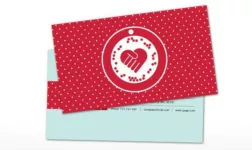Bleamcard is a cool augmented reality enhanced business card/smartphone combination that lets you add an impressive array of information, pictures even video to a standard paper business card.
The system is quite clever in that it combines a traditional business card with a smartphone app that scans a proprietary code printed on the card and links to an online database to send 3D buttons to the smartphone. The buttons appear to float over the business card and when pressed can bring up the card owner’s picture, contact information, website, brochures, videos or just about any type of information the card owner wishes to communicate.
The French company already has a business card/smartphone app combination that allows users to scan the card and see an instant link back to the company’s website. Now they want to create a centralized repository of data so customers can upload customized information. The enhanced version of the card would also allow users to track when and where their cards are accessed.

About the technology behind the Bleamcard the company’s indiegogo.com page states (in slightly broken English):
The bleam is a 2D visual code, designed for fast reading in mobility (standard camera sensor) and to trigger 3D interactions (augmented reality). It takes all advantages of classic barcodes (QR code, EAN 13, …) designed for tracaeability and those of augmented reality (Image Recognition, AR Tag, …). Ubleam designed and patented this technology.
Based on conics algorithms, this techno enables any smartphone to read the code in 3 dimensions very quickly (less than 3 ms) while keeping robustness to distorsions (occultation, blur, torsion, …).
The Bleam is graphically composed with:
1.a plain ring with an oriented point
2.coding points using contrast
3.central zone, free for graphical customization
The bleam is the alternative to other technologies that solve issues of compatibility, design and scan performances. It can be printed in color or black & white with a 5mm minimal size.
It’s an interesting concept that could easily be ported to other applications. A restaurant could put a bleam logo on their door for people passing by to scan in order to see menus, pictures of the dishes or make reservations. Billboards could sport a bleam logo to pass much more information to readers. Products could also use a bleam logo on packaging to provide potential customers with data, videos of the product in action or activate special coupons.
The biggest problem with the Bleamcard is that people have to download an app to access the embedded information. It’s a little like putting the horse before the cart, but once they have enough horses they should be able to push the cart along.
The company is looking to raise €50,000EUR on indiegogo.com. So far they have raised €10,975EUR and have 11 days left to go.
Check out their campaign here.








